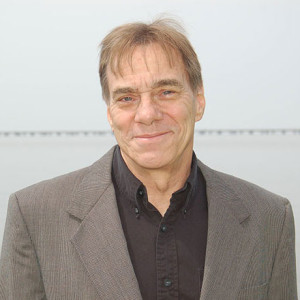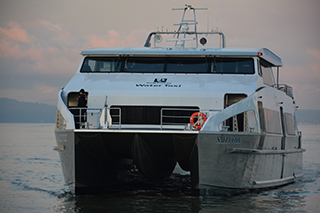As I prepare for tomorrow's opening day of the International WorkBoat Show, my mind keeps returning to the Pacific Marine Expo, held earlier this month in Seattle. While I was at PME, I hitched a ride on King County’s 105'x33' aluminum catamaran ferry Sally Fox.
The Sally Fox. Ken Hocke photo. The boat, built by All American Marine, Bellingham, Wash., was the first Subchapter K-inspected passenger vessel built and delivered (in March 2015) under the new 5A Space Performance Guidelines issued in NVIC 9-97, Ch-1 released in 2010. The NVIC was a result of a working group between the U.S. Coast Guard and the Passenger Vessel Association. The new guidelines make it possible for boatbuilders to design and implement suitable structural fire protection in very low fire load spaces in the construction of weight-sensitive, high-speed passenger vessels.
“We also wanted to keep these boats as green as possible,” Paul Brodeur, King County’s marine division director, said during the trip from downtown Seattle to Vashon Island (a sistership to the Sally Fox, the Doc Maynard, was delivered earlier this fall). “I didn’t want to put paint on the boat which will also keep our on-going maintenance costs down.” As an environmentally friendly alternative to paint, the decks are covered with peel-and-stick non-slip tread, and the exterior of the superstructure is wrapped in UV-stable vinyl.
All American partnered with Teknicraft Design Ltd., Auckland, New Zealand, for the hull design. Both new ferries feature a hull shape that was custom designed using digital modeling and computational fluid dynamics (CFD) analysis testing. The hull design is complemented by Teknicraft’s integration of a wave piercer that is positioned between the catamaran sponsons to break up wave action and ensure reduced drag while enhancing passenger comfort. The ride is smooth enough to get your attention. “These boats give us a smooth, quiet ride,” said Brodeur. “Some older boats felt like you were getting airborne in some wakes. That doesn’t happen in these boats.”
The catamaran is powered by twin Cummins QSK-50 Tier 3 engines, each rated at 1,800 hp at 1,900 rpm, that provide a service speed of 28 knots. The design features interior seating for 250 with 28 additional outdoor seats available. “The outdoor area is important to the customers,” said Brodeur as we waited for passengers to board from the island. “Even in the cold, you’ll find some passengers that want to ride out there. It’s what they wanted.”
The main deck is ADA-accessible and the cabin includes designated seating areas for those with disabilities. The aft deck includes a staggered-height storage rack for 26 bicycles.
The $6.5 million boats were 80% funded by a Federal Transit Administration grant and 20% from local matching funds. “It’s been a 10-year process to get these boats delivered,” Brodeur said as we exited the Sally Fox in downtown Seattle. “The county had never really built any boats. Now we have a learning curve for next time.”




